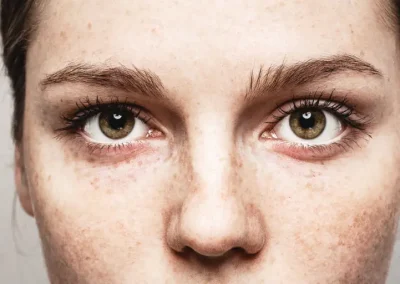Blue Light: What It Is and Why It Matters
Your smartphone, tablet, and computer have one crucial thing in common. They all emit blue light. And as you may have heard, blue light isn’t a friend to your physical health. Blue light has a high-energy light wave and significantly affects our bodies and our eyes in multiple ways, one of the scariest being our sleep. This is a proven fact, but blue light’s effects go much deeper than poor sleep.
Whether you’re working late hours during the pandemic, adapting to the at-home virtual classroom with your children, watching more TV because you spend more time at home, or all of the above, it’s clear that screen time is at the center of our lives more than ever before. And because of that, blue light is everywhere.
Think back to grade school. You may remember learning the fun mnemonic device ROYGBIV to memorize the colors in the visible light spectrum: red, orange, yellow, green, blue, indigo, and violet. We’re here to talk about the BIV. Blue light (which we define as blue-violet through blue-green) has a short wavelength and high energy. It falls just shy of UV rays on the light spectrum. It can be nearly as dangerous, and like UV rays, it’s hard to escape.
While the sun is our biggest source of blue light, we are also surrounded by artificial sources of blue light thanks to modern technology — from the LED light bulbs in your lamps to your smartphone screen. Since it’s not uncommon to spend more time indoors staring at a screen than outside no-screens-attached, it’s important to consider how all of that artificial blue light (particularly at night) affects your physical health.
The energy of light waves start at very high energy gamma rays and go all the way to very low energy radio waves. We all understand that gamma rays that kill cancer must have a lot of energy. We know that X-rays can be dangerous if overexposed. We know that we should protect ourselves from chronic UV light exposure. But blue light is just below the UV level and is now a huge part of our LED world. We’re exposed to it constantly without a second thought. And more importantly, blue light controls our sleep cycle.
Blue Light and Your Health—The Bigger Picture
Blue light’s job is to make you feel more awake and alert; it’s why sunlight is nature’s alarm clock. Although these characteristics are useful during the daytime, it’s exposure to blue light at night that we should be worried about. Research has shown that using a digital device that emits blue light before bedtime can make it harder to fall asleep, disrupting the natural circadian rhythm.
While losing a little sleep at night may have seemed like no big deal, we know that chronic? sleep deprivation is linked to various health problems such as depression, heart disease, high blood pressure and stroke. When blue light keeps you awake at night or reduces your sleep quality, it does more than make you feel groggy the next morning.
This is because blue light in the evening and at night can suppress melatonin in the body, a hormone so important that its effects range from promoting sleep to forming memories to preventing cancer. Melatonin is essential in DNA repair, metabolism control, and is a powerful antioxidant, to name a few. Alterations in the melatonin pathway are known to be associated with increased rates of cancer. In fact, the World Health Organization has stated that nocturnal light exposure (delete especially? especially studied in shift workers) is carcinogenic!
Studies also show that it can increase your risk of diabetes and obesity, in addition to heart disease and high blood pressure. Even more relevant with the pandemic in play, lack of sleep can impact your immune health in a big way. One study published in the Biobehavioral Journal of Medicine found that our bodies’ natural killer cells, which are crucial for fighting off disease, decreased by 70% when we lose just four hours of sleep in one night. Blue light can also negatively impact your weight. A study published in JAMA Internal Medicine revealed that artificial light at night increases a women’s woman’s risk of weight gain and obesity. (not men?)
One more important fact in the age of online learning, blue light limits your memory formation. Imagine studying and learning all day long only to fail to make that knowledge stick because you ruined the sleep cycle that helps you turn that new information into long-term memory. Melatonin suppression decreases REM sleep, and lack of REM sleep hinders your memory formation. When you miss out on REM sleep, your brain doesn’t have the opportunity to recover and form long-term memories. Even relaxing with an e-reader, phone or computer before bed will cause this disruption unless you protect yourself from the blue light exposure.
We can’t forget the effect on our eyes themselves. We know that the high-energy blue light causes cellular damage to the retinal photoreceptors even in low, chronic doses. This oxidative damage works in the same pathway that causes macular degeneration, a leading cause of irreversible blindness. Similar to how smoking causes lung cancer, the slow exposure over time causes damage little by little but it’s undeniable. We don’t yet know how fast this damage is happening because our exposure to blue light LEDs is fairly new. That said, it just increased dramatically (as well all) with so many working work) from home. We are living through the experiment right now to discover how quickly blue light damage happens.
Bottom Line: Blue Light Matters
And it’s dangerous. It’s more important than ever to be aware of screen time and take preventative measures to protect ourselves from blue light. Researchers have estimated that working from home during the pandemic has increased workdays by about three hours. Parents have to take strategic breaks during the day to entertain and educate their children, which means signing back on at night to finish their to-do list and answer emails.
The good news in all of this? You can control your exposure to blue light with a few best practices. The short answer is to decrease the blue light exposure before bed and increase it first thing in the morning. While the best strategy is to unplug two hours before bedtime, that answer just isn’t practical for most of us. The world is more reliant on digital devices than ever, and asking it to go back is a losing battle.
Luckily, there are already some easy and impactful measures we can take to counteract many of the negative effects of blue light. But this starts with realizing there is a problem that we need to do something about.
Step 1: Cover your screens. The vast majority of the “blue light blocking” glasses are garbage. Dr. Kara Hartl has reviewed countless products and companies and strongly endorses the screen protectors from Reticare (www.reticare.com). This company was founded by scientists and has validated the protective effects with clinical studies using both retinal cell cultures and animal models. Their product works and they have the science to prove it. Use the promo code drkara for a 10% discount and 10% more gets donated to the educational initiative.
Step 2: Eat a healthy diet that includes foods rich in Lutein and Zeaxanthin. These are pigments that are absorbed by our eyes and protect you from the harmful energy in blue lights. You have to eat them, your body doesn’t make them. Foods such as kale, spinach, Swiss chard, sweet potatoes, butternut squash, egg yolks are great examples. Alternatively, you can purchase these supplements in most stores as they are recommended to help patients with macular degeneration protect their eyes.
Step 3: You MUST use yellow glasses at night. The regular screen covers are good, but your melatonin pathways need more. There are many commercially available blue blocking glasses that work wonderfully, but they are all very, very yellow. If you put on the glasses and can still see the color blue, it’s not actually blocking the blue light. Amazon has several versions, but another product with much higher quality optics, which has excellent science behind it, is Melanin Products (www.melaninproducts.com). They are expensive and I have no promo code yet, but these are an actual medical device with scientific studies to substantiate the results.
Step 4: Get sunlight in the morning. If you live in Alaska like I do, get full spectrum light in the morning to supplement your lack of natural sunlight. This will help keep that circadian rhythm on track. Also, get your kids outside during the daylight. It prevents myopia (nearsightedness).



